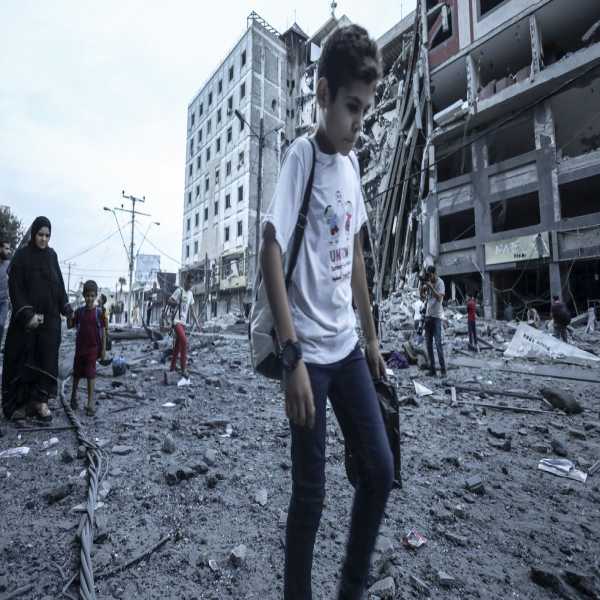Here’s how a war between Israel and Hamas could play out.

Palestinians walk past the rubble of destroyed buildings after an Israeli air strike in Gaza City on October 8, 2023. Sameh Rahmi/NurPhoto via Getty Images Ellen Ioanes covers breaking and general assignment news as the weekend reporter at Vox. She previously worked at Business Insider covering the military and global conflicts.
Israel suffered its most devastating attack in decades Saturday when Hamas militants launched thousands of rockets from Gaza and infiltrated several Israeli towns, killing hundreds of people and taking an as-yet-unknown number of hostages, both military and civilian.
Given the scale and brutality of the attack, Israel may launch a ground invasion in Gaza, in addition to the airstrikes the military is already conducting in the region. That could mean a long, bloody battle with significant deaths on both sides, but with Palestinians bearing the brunt of the casualties and destruction.
The death toll on both sides is already in the hundreds, with injuries from airstrikes in Gaza and rocket attacks and gunfights in southern Israel numbering in the thousands. The Israel Defense Forces, or IDF, began launching retaliatory strikes shortly after the initial shock invasion Saturday; on Sunday, Israeli Prime Minister Benjamin Netanyahu officially declared war against Hamas. Although the next phase of Israel’s operation in Gaza hasn’t yet unfolded, it’s likely to be catastrophic given previous conflicts between Israel and Gaza, as well as Netanyahu’s heightened rhetoric.
“In a way, this is our 9/11,” IDF spokesperson Lt. Col. Richard Hecht said in a video statement posted to the social network X (formerly Twitter) on Sunday. Videos have circulated showing dead Israelis, as well as Israeli civilians being captured by Hamas militants, presumably to be held in Gaza. Though some hostages in Israeli towns near the Gaza border have been freed and their captors killed, many remain in captivity and some are presumed dead.
Related
Why did Hamas invade Israel?
Netanyahu, meanwhile, has told Gazans to leave the territory and threatened to turn it into “a deserted island,” Al Jazeera reported Sunday; many civilians are sheltering at schools built by the UN agency for Palestinian Refugees, UNRWA, some of which have been damaged by Israeli airstrikes, the Associated Press reports.
Israel has fought multiple wars against Palestinians and Arab nations including Syria and Egypt; it has also launched ground operations in Gaza, most recently in 2014. Though Israeli military policy is to use disproportionate force in Gaza as a deterrent strategy, that has so far failed to enact durable security, limit Hamas’s ability to strike Israel, or allow space in Israeli politics for any sort of political negotiation that could lead to a more peaceful future.
Civilians have reportedly left Gaza City and areas near the border in anticipation of a ground invasion, according to the New York Times, and Netanyahu has called up IDF reservists and ordered 24 villages and towns near the border to be evacuated. The government has also shut off electricity to the region and halted the flow of fuel and goods to Gaza, which has been under blockade by Israel and Egypt for 16 years.
What are the odds of a ground invasion of Gaza?
“I don’t know the likelihood of a ground invasion — I would say, if I were calculating odds, the chances of a ground invasion are greater than they were in previous rounds of violence in Gaza,” Khaled Elgindy, director of the Middle East Institute’s Program on Palestine and Palestinian-Israeli Affairs, told Vox. “In the past, we’ve seen reports of ground invasions being imminent and they’ve turned out to be inaccurate or even deliberate misinformation put out there by the Israeli military.”
The Netanyahu government has typically preferred airstrikes to retaliate against Hamas’s rocket attacks, as they minimize Israeli casualties and inflict serious damage in Gaza. During the last major attack on Gaza, in May 2021, Israeli airstrikes ostensibly targeting Hamas leadership and targets also hit civilian sites including media offices, residential buildings, and health care facilities. More than 250 Palestinians and 13 Israelis were killed in the 11-day conflict.
“Netanyahu … he’s always been very cautious around widespread use of military force,” Daniel Byman, a senior fellow at the Center for Strategic and International Studies, told Vox. “He hasn’t done the kind of big wars like we saw in Lebanon in 2006, so he tends to be cautious. But it may be hard to be cautious in these circumstances.”
Israel has put boots on the ground in Gaza before, and occupied the territory from 1967 to 2005, when it unilaterally withdrew from the region.
When they are ordered, ground incursions tend to be horrific, causing devastating infrastructure damage and heavy civilian casualties on the Palestinian side. In 2014, simmering conflict in Gaza exploded into a major Hamas rocket offensive into Israel, which responded with a 19-day ground invasion. Though there was an Egypt-mediated ceasefire in August of that year, 2,251 Palestinians — including 1,462 civilians — and 73 Israelis were killed in the fighting, according to the United Nations Office for the Coordination of Humanitarian Affairs.
Natan Sachs, director of the Center for Middle East Policy at the Brookings Institution, told Vox that, given the nature of the attack and current public and political sentiment in Israel, a ground invasion was “very likely.”
“The mood in Israel is such that another round of airstrikes or something like that is seen to pale in comparison to the task,” he said, “not only for the general mood of vengeance in the country — which is certainly there — but also the question of how can Hamas capabilities actually be degraded and a repeat of some sort be prevented.”
Operation Cast Lead in 2008 and 2009 wreaked havoc on the Gaza Strip; the first day of airstrikes alone killed 230 Palestinians. After a week of intensive aerial bombardment, Israeli forces launched a two-week invasion from the north and the east while Israel’s navy shelled the area from the sea. Overall, though sources vary in specifics, around 1,400 Palestinians and nine Israelis were killed during that operation.
Related
This Gaza war didn’t come out of nowhere
Israel’s asymmetric response is supposed to serve a deterrent purpose, Byman told Vox, but the country has also, at least in the past, had a vested interest in keeping Hamas in power. According to a 2017 research brief by the RAND corporation, Israel has the military capability to wipe out Hamas, but doing so could perhaps be even riskier than not, given that an even more extreme organization could come into power — or that Israel could be put into the position of governing the territory itself. “As such, Israel’s grand strategy became ‘mowing the grass’ — accepting its inability to permanently solve the problem and instead repeatedly targeting leadership of Palestinian militant organizations to keep violence manageable.”
“We want to break their bones without putting them in the hospital,” one Israeli defense analyst told the research brief’s authors.
Here’s what a ground war might look like, given what we know
Just two days into the war, what comes next is impossible to predict. But given what’s known about previous conflicts and the capabilities of both sides, the coming weeks are likely to be bloody. UN agencies have urged both sides to avoid civilian casualties, though reports of civilian deaths on both sides are already high.
“The immediate phase will be Israel sweeping up its own villages and towns, making sure that there are no Hamas fighters left there,” Sachs said. The IDF confirmed that assessment in an email statement to Vox.
Israel will then need to gather intelligence on where Hamas leadership is and determine the number of hostages missing and their locations, which will be a challenging task, Sachs said.
International leaders have affirmed unwavering support for Israel, and the US has pledged to send additional military materiel, “including munitions,” according to a press release from the Defense Department, with the first tranche of security assistance headed to Israel today.
In addition to the materiel support, Defense Secretary Lloyd Austin said in Sunday afternoon’s statement that the USS Gerald R. Ford Carrier Strike Group, which includes an aircraft carrier and multiple guided missile destroyers, has been deployed to the eastern Mediterranean.
“We have also taken steps to augment U.S. Air Force F-35, F-15, F-16, and A-10 fighter aircraft squadrons in the region,” the statement reads. DoD did not respond to Vox’s additional questions about this change in force posture by publication time Sunday, but such a show of force is likely meant to serve as a deterrent to other actors like Hezbollah or Iran.
Despite the overwhelming Israeli and US military might it faces, Hamas has not yet shown signs of backing down.
“Hamas has lost the element of surprise but it has likely prepared to stick in for the long haul, probably has a lot of supplies,” Colin Clarke, research director at the Soufan Group, told Vox in an email. “I think Hamas still has a robust arsenal of rockets and could be planning more ambushes. I wouldn’t be surprised to see suicide bombings, if Hamas is able to infiltrate more operatives onto Israeli soil. But once Israel gears up and mobilizes, its military is likely to make quick work of Hamas, killing and capturing its leaders and decimating its infrastructure.”
And despite the possibility — even likelihood — of serious casualties in the coming days and weeks, Sachs said, “Israel is not about to de-escalate now.”
Sourse: vox.com






